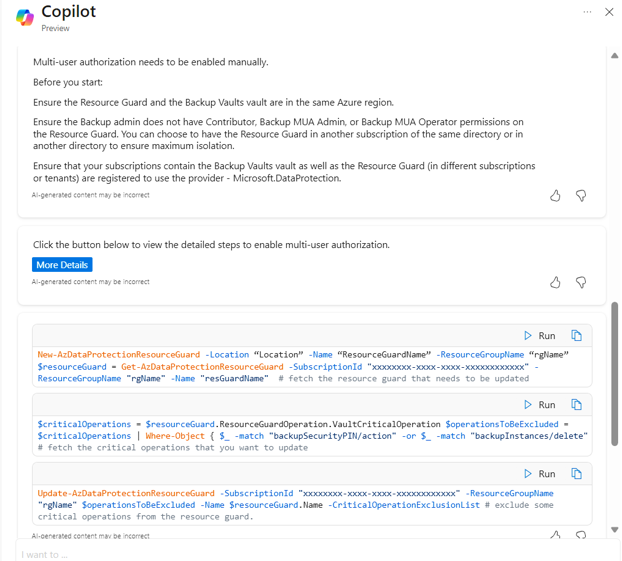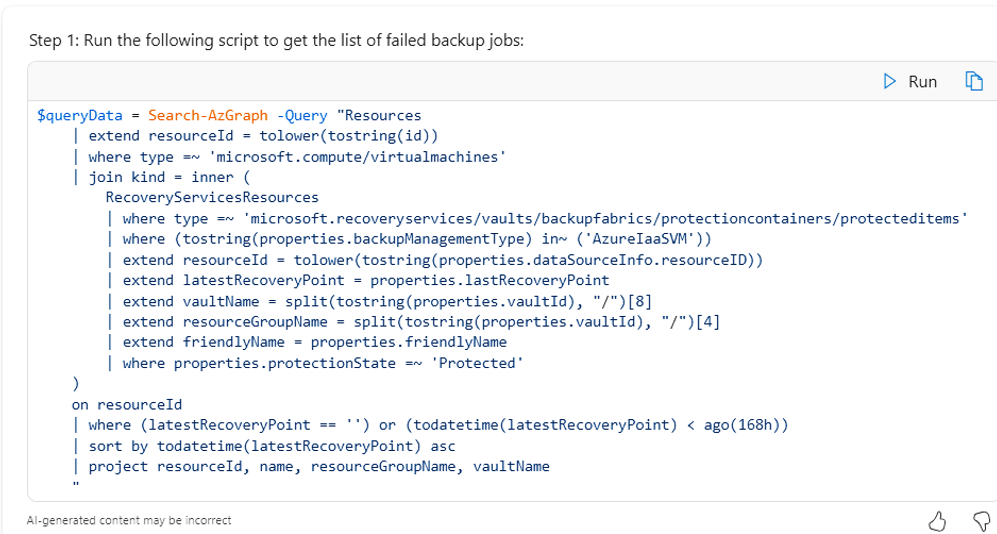Note
Access to this page requires authorization. You can try signing in or changing directories.
Access to this page requires authorization. You can try changing directories.
This article describes how to use Azure Business Continuity Center Copilot to make your business continuity journey seamless.
What is Azure Business Continuity Center Copilot?
The Azure Business Continuity Center Copilot feature assists you to protect and recover your resources. The key use cases for the Azure Business Continuity Center Copilot are prioritized by the four Business Continuity and Disaster Recovery (BCDR) pillars:
- Protection management
- Ransomware protection
- Monitoring and reporting
- Learn and get help on capabilities
With Azure Business Continuity Center Copilot (preview), you can check for the protection status of your Azure resources in the Azure portal using natural language directly. The Copilot retrieves information about your resources and their protection status and guides you through the relevant processes.
Sample prompts
The following table lists the supported prompts:
| Category | Prompts |
|---|---|
| Security | - How many vaults are in poor security level? - Show security level of all the vaults. - How can I increase the security level of a vault? |
| Management | - Show the BCDR real estate across all the subscriptions. - Show the datasources that aren't protected in XXX regions. - Show me a list of all datasources that are protected using Azure Site Recovery only. |
| Monitoring | - Which data sources don't have Recovery Points (RP) in the last seven days? - How many backup jobs failed in the last 12 hours? - Retrigger backup for all failed backup jobs in the last 24 hours. |
View the BCDR real estate across all the subscriptions
Ask Copilot for Azure Business Continuity Center (preview) to get information on your resource protection with prompts such as Show the BCDR real estate across all the subscriptions.
Copilot provides a summary of resources based on the protection status and generates an Azure Resource Graph (ARG) query that you can run directly to fetch granular information. Additionally, you can export the data as a CSV file from the ARG Query Explorer page.
Enhance protection for the resources
Copilot also helps you to improve resilience by enhancing the protection of existing resources. With this feature, you can enable protection using multiple available solutions.
Note
This feature is available for Azure VMs only.
To enhance protection of your resources, follow these steps:
In the Azure portal, select Copilot, and then use the prompt Show the running Virtual Machines.
On Select resources, choose your virtual machine, and then click Select.
On the selected VM blade, Copilot shows the current solution with which the Virtual Machine (VM) is protected. Select Enhance Protection to proceed with protection enhancement.
Copilot redirects to the blade from where you can configure protection with other solutions.
The specific solution blade appears where you can configure backup or disaster recovery.
View the security level
You can ask Copilot for a summary of your security posture and get guidance to enhance the security.
To view the security level of resources on Copilot, use the prompt Show security level for all datasources. Copilot provides a summary of the number of datasources based on their security levels.
You can also run an ARG query to fetch more details or download the data as a CSV file.
Increase the security configuration
You can also ask Copilot to help enhance your security posture.
To increase the security configuration, follow these steps:
In the Azure portal, on Copilot, use the prompt Increase security level for vault. Copilot provides a series of steps to enable various security features.
On Select resources, choose a vault, either a Recovery Services vault or a Backup vault, and then click Select.
Review the current security level, and then use Copilot to choose the required target level.
Choose the way you want to proceed, through the Azure portal or CLI tools.
If you select Command tools (PowerShell/CLI), Copilot provides the script for download from the Azure portal to modify the security levels.
Copilot lists through each security feature and tries to update it so that the desired security level is reached. Select the required options to increase the security levels.
Some security features, such as Multi-user authorization, require more manual intervention. Copilot provides the process to modify the security settings.
Trigger backup for resources
Copilot can help you get a list of datasources that don’t have any Recovery Point in a specified duration. This feature helps to monitor any backup failures and maintain service level agreement (SLA) for recovery.
To trigger an on-demand backup for resources, follow these steps:
In the Azure portal, on Copilot, trigger a query to check for resources that don't have Recovery Point by using the prompt How many datasources don’t have Recovery Point in the last 7 days.
Copilot shows a list of such resources and the ARG query to fetch more details.
Azure Business Continuity Center Copilot (preview) also provides a PowerShell script for download from the Azure portal to trigger backups on all such resources.
To trigger an on-demand backup, select Yes on the further prompt.
The following screenshots show, the scripts to fetch the list of failed backup jobs and to trigger backups for them.
You can also fetch a list of failed backup jobs in a given time period.
Increase security level of Recovery Service vault and Backup vault
Azure Business Continuity Center Copilot provides the option to enhance the security level of the vault. You can find this option on the vault pane.
To increase the vault's security level, follow these steps:
Go to the vault for which you want to increase the security level, and then select Increase security level of this vault.
The Copilot pane opens on which you can interact with Copilot to do the required security enhancements.
In the following screenshot, Copilot shows the vault's current security level and suggests the next level (Poor to Fair, Fair to Good, or Good to Excellent) along with recommended steps to upgrade it.
After you select the required security level (for example, Good), copilot asks to choose the preferred execution option - Portal or Command tools (PowerShell/CLI).
To use the Azure portal for security enhancement, select Portal. This selection guides you with the options to enhance Soft delete, Immutability, and Multi-user authorization (MUA) settings.
The Command tools (PowerShell/CLI) allows you to enable vault security features via command lines, with Copilot offering sample commands for activation.
After you update the vault security level using Copilot, select View properties to check the updated values.
Analyze job failures for Recovery Service vault and Backup vault
The vault page also provides the Azure Business Continuity Center Copilot feature to analyze the job failures for the selected vault.
To check the failed jobs, follow these steps:
Go to the vault for which you want to review the failed jobs, and then select Show job failures for this vault.
The Copilot pane opens with the prompt to view the impacted resources.
Select Yes.
The Select resources pane opens with a summary of the top failed jobs from the last 24 hours for the backup items, and then prompts to select the impacted resource to further analyze the error and check for recommended actions from Copilot.
Choose the affected resource from the list, and then click Select.
On the Copilot pane, select Open Backup Item to view the error code descriptions and recommendations with guided steps to fix issues.
Troubleshoot error codes for Recovery service vaults and Backup vaults
You can use Copilot to troubleshoot the job failures associated with a Recovery Services vault or a Backup vault.
To troubleshoot the error codes, follow these steps:
Go to the vault > Backup jobs.
The Backup jobs pane opens with the list of jobs and their status. You can further analyze the job failures for the vault.
Filter by resource type, and then select the failed job to open the job details or properties pane for troubleshooting steps based on the error code.
In the following screenshot, the job details show the cause of the error and Copilot provides the options to troubleshoot the error.
























